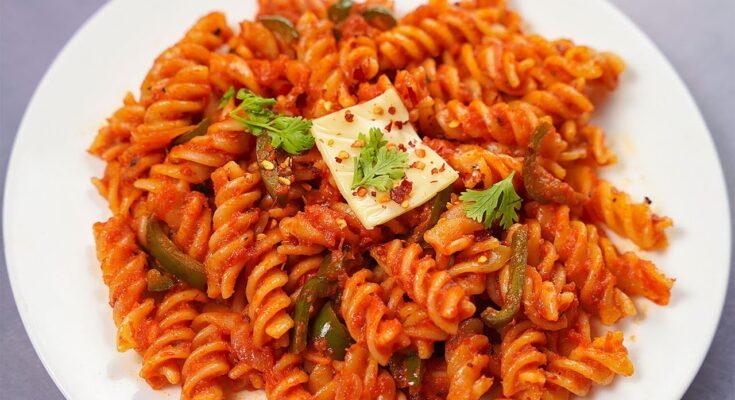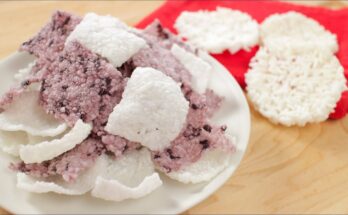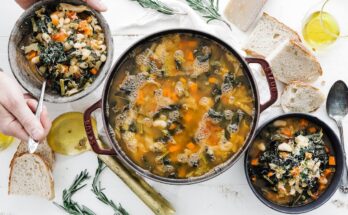Red Sauce Pasta Recipe: Red Sauce Pasta is a classic comfort food loved across cultures. It’s an Italian-origin dish where pasta is coated in a savory tomato-based sauce, rich in flavor and often infused with garlic, onions, herbs, and sometimes cheese. This vibrant dish gets its name from the bright red color of the tomato sauce, and it’s typically made using penne, spaghetti, or fusilli pasta. The sauce can be as simple or as elaborate as you wish—made with fresh tomatoes, tomato puree, or canned tomato paste. Whether you’re a beginner in the kitchen or a seasoned home chef, this dish is accessible, easy to prepare, and incredibly satisfying.
Why Everyone Loves It
Red Sauce Pasta has earned its spot as a household favorite for a reason. Its bold, tangy, and slightly sweet flavor profile is universally appealing. It’s a great go-to for lunch, dinner, or even meal prepping for the week. It’s also highly customizable—you can add vegetables, meats, or even tofu for extra protein. Plus, it’s vegetarian-friendly and can easily be made vegan or gluten-free. Its versatility, simplicity, and budget-friendly nature make it a staple in many kitchens. From picky eaters to food connoisseurs, red sauce pasta never fails to please.
Origin and Popularity Around the World
Though its roots trace back to Italian cuisine, red sauce pasta has gone global. In India, it’s often spiced up with chili flakes and masala. In the U.S., it’s a weeknight dinner staple. In France and other parts of Europe, it’s served alongside gourmet ingredients like olives, capers, or seafood. The beauty of red sauce pasta is that it adapts seamlessly to local tastes while maintaining its core essence—pasta enveloped in a rich, tomato-based sauce.
Ingredients You’ll Need
Basic Ingredients for the Red Sauce
Here’s a list of must-have ingredients to whip up a delicious red sauce pasta:
- Pasta (Penne, Fusilli, or Spaghetti – 250g)
- Olive oil – 2 tablespoons
- Garlic cloves (minced) – 4
- Onion (finely chopped) – 1 medium
- Tomatoes (blanched and pureed or canned) – 4 large or 2 cups puree
- Tomato paste – 2 tablespoons (for a richer taste)
- Salt – to taste
- Black pepper – 1 teaspoon
- Red chili flakes – 1 teaspoon (optional for heat)
- Oregano – 1 teaspoon
- Basil leaves – fresh or dried, 1 teaspoon
- Sugar – 1/2 teaspoon (to balance acidity)
These core ingredients create a delicious, balanced red sauce. Use high-quality tomatoes and olive oil for the best flavor.
Optional Add-ons for Extra Flavor
Want to elevate the dish? Consider adding:
- Parmesan cheese – grated, for topping
- Mushrooms – sautéed for an earthy twist
- Bell peppers – for crunch and sweetness
- Olives or capers – for a tangy kick
- Spinach or kale – for a healthy boost
- Chicken or sausage – for a non-veg version
Substitutions and Alternatives
No fresh tomatoes? Use canned crushed tomatoes or passata. Out of oregano? Italian seasoning works fine. Need it vegan? Skip the cheese or use vegan alternatives. Gluten-free? Swap pasta with rice pasta or chickpea pasta. This recipe is flexible—just adjust to what you have in your pantry.
Kitchen Tools You’ll Need
Essential Utensils
Having the right tools makes the cooking process smooth:
- Large pot – for boiling pasta
- Non-stick pan or saucepan – for preparing the sauce
- Colander – to drain pasta
- Wooden spoon or spatula – for stirring
- Knife and chopping board – for prepping ingredients
Cooking Equipment Checklist
- Blender or food processor – if making fresh tomato puree
- Grater – for cheese
- Measuring spoons and cups – to get proportions right
- Lid for the pan – to simmer the sauce without splattering
Cooking red sauce pasta doesn’t require fancy gadgets, just a few essentials to get it right every time.
Prepping Your Ingredients
Chopping, Dicing, and Measuring
Preparation is the key to efficiency in cooking. Start by dicing the onions and mincing the garlic finely. If you’re using fresh tomatoes, blanch them in hot water, peel off the skin, and blend until smooth. Measure out all spices, herbs, and liquids before turning on the stove. This not only saves time but ensures you don’t miss any ingredients mid-recipe.
Tips for Prepping Efficiently
- Use a sharp knife—it makes chopping quicker and safer.
- Keep ingredients in small bowls to stay organized.
- Wash herbs like basil and spinach beforehand and pat dry.
- Soak pasta in warm water for 10 minutes before boiling—it shortens cooking time.
Efficient prep equals stress-free cooking, especially when juggling multiple ingredients.
How to Make Red Sauce Pasta – Step-by-Step Guide
Step 1: Boiling the Pasta Perfectly
Bring a large pot of salted water to a boil, add your pasta, and cook until al dente (slightly firm to the bite). Stir occasionally to prevent sticking. Drain but don’t rinse — the starch helps the sauce cling better.
Step 2: Preparing the Red Sauce
Heat olive oil in a pan, sauté onions until golden, then add minced garlic. Stir in chopped tomatoes or puree, season with salt, pepper, chili flakes, oregano, and basil. Let it cook until thick and flavorful.
Step 3: Mixing Pasta with Sauce
Add the boiled pasta to the sauce and toss well until every piece is evenly coated. Add a splash of pasta water if needed to loosen the sauce.
Step 4: Simmering and Flavor Balancing
Let it simmer for 2–3 minutes so the flavors meld. Taste and adjust seasoning — a touch of sugar can balance the acidity.
Step 5: Garnishing and Serving
Turn off the heat, sprinkle grated cheese, and garnish with fresh basil or parsley. Serve hot with garlic bread and a drizzle of olive oil. Perfect comfort in a bowl!
Cooking Tips & Tricks for the Perfect Pasta
Avoiding Common Mistakes
Even the simplest pasta recipes can go wrong with a few missteps. Here’s how to avoid them:
- Don’t overcook the pasta – Al dente is key. Mushy pasta ruins texture.
- Avoid watery sauce – Always simmer long enough to thicken the sauce.
- Don’t skip seasoning – Taste as you go and balance acidity with sugar or herbs.
- Never rinse pasta under water – Unless it’s for a cold pasta salad, rinsing removes the starch that helps sauce cling.
- Don’t add oil to boiling water – It doesn’t prevent sticking and may coat the pasta, making it harder for sauce to stick.
Tips to Enhance Flavor
- Use caramelized onions or roasted garlic for a deeper flavor.
- Add a splash of red wine to the sauce while cooking.
- Sprinkle some nutritional yeast or smoked paprika for a unique twist.
- Always finish with fresh herbs for brightness and aroma.
Making It Restaurant-Style at Home
Want that silky, rich flavor you get at a fine-dining spot? Here’s how:
- Use tomato paste for richness.
- Incorporate a little butter or cream at the end for body.
- Toss pasta with the sauce instead of pouring sauce over pasta—it ensures better absorption and flavor.
- Garnish like a pro—use color, texture, and height.
Restaurant-style pasta isn’t about fancy ingredients—it’s about small, smart tweaks that elevate the dish.
Nutritional Value of Red Sauce Pasta
Calories and Macronutrients
Red sauce pasta isn’t just delicious—it can be relatively healthy too, depending on how you prepare it. A standard serving of red sauce pasta (1 cup) made with olive oil, tomatoes, onions, and basic seasonings contains approximately:
- Calories: 250–350 kcal
- Carbohydrates: 40–50g
- Protein: 7–10g
- Fat: 7–12g
- Fiber: 3–6g
If you add cheese, cream, or meat, the calorie and fat content will increase. Using whole wheat pasta or adding veggies like spinach, broccoli, or mushrooms can boost fiber and micronutrient levels. The tomatoes in the sauce are rich in lycopene, a powerful antioxidant known for its cancer-fighting properties. Garlic adds anti-inflammatory benefits, while olive oil contributes healthy fats.
This dish provides a good balance of carbs, fats, and protein when paired with a salad or protein-rich side. For those watching their intake, opt for low-fat cheese, use whole grain pasta, and add loads of vegetables.
Health Benefits and Concerns
Health Benefits:
- Rich in antioxidants like lycopene (from tomatoes)
- Heart-healthy fats from olive oil
- Energy-boosting carbohydrates
- Great for vegetarians and can be adapted for vegans
- High in fiber (if using whole grains or adding veggies)
Concerns:
- Can be high in carbs—moderation is key
- Store-bought sauces can contain added sugars and preservatives
- Cheese and cream versions may increase saturated fat intake
To keep it healthy, always go for fresh ingredients, avoid processed sauces, and control portion sizes.
Variations of Red Sauce Pasta
Spicy Red Sauce Pasta
Love heat? Turn up the spice! Add extra chili flakes, chopped green chilies, or a dash of hot sauce to the red sauce while cooking. Sauté some jalapeños or even smoked paprika to infuse the sauce with a bold, fiery kick. Garnish with chili oil or chili-infused olive oil for a dramatic, spicy finish.
Pro tip: If your spice tolerance is high, throw in some cayenne pepper or ghost chili powder—but be cautious!
Creamy Tomato Pasta
For a richer, creamier version of red sauce pasta, stir in heavy cream, milk, or cream cheese once the tomato sauce is done simmering. This creates a smooth, velvety texture that’s comforting and indulgent. Add a touch of nutmeg or garlic butter for an extra luxurious flavor.
This creamy version pairs beautifully with penne or farfalle pasta and is often a crowd-pleaser at gatherings.
Vegan and Gluten-Free Variations
- Vegan: Use plant-based butter or olive oil, skip the cheese or use vegan cheese, and load the sauce with veggies like mushrooms, zucchini, and spinach.
- Gluten-Free: Substitute regular pasta with gluten-free options like rice pasta, corn pasta, or chickpea pasta. The flavor of the sauce stays the same, and you won’t even miss the gluten!
Red sauce pasta is highly adaptable, which makes it suitable for all dietary lifestyles with just minor changes.
Perfect Pairings with Red Sauce Pasta
Best Side Dishes
A good pasta meal deserves great companions. Here are some sides that make your red sauce pasta shine:
- Garlic Bread – crispy on the outside, soft inside, perfect for soaking up extra sauce
- Caesar Salad – crunchy romaine with creamy dressing complements the tangy tomato sauce
- Caprese Salad – fresh tomatoes, mozzarella, and basil drizzled with balsamic
- Roasted Vegetables – zucchini, bell peppers, and broccoli work great
- Soup – tomato basil or minestrone pairs well
These sides enhance the meal without overpowering the main dish.
Wine and Beverage Pairings
Red sauce pasta pairs excellently with both alcoholic and non-alcoholic drinks. Here’s a quick guide:
- Wine: Chianti, Merlot, or Pinot Noir – medium-bodied reds with a fruity undertone
- Beer: Light lagers or wheat beers balance the acidity
- Mocktails: Sparkling lemonade, basil-cucumber soda
- Juices: Grape or pomegranate juice works well with the tartness of the tomatoes
If you’re hosting a dinner, these beverages can elevate your pasta night to an elegant experience.
Storing and Reheating Tips
Best Ways to Store Leftovers
Got leftovers? No problem! Red sauce pasta stores well and often tastes even better the next day.
- Storage: Transfer to an airtight container once it cools completely.
- Fridge: Store for up to 3–4 days.
- Freezer: Store in freezer-safe bags or containers for up to 1 month. Label with the date.
If possible, store sauce and pasta separately to retain texture. But if they’re already mixed, it’s still fine—just follow proper storage.
Reheating Without Losing Flavor
- Microwave: Add a splash of water or milk before reheating to rehydrate the pasta. Microwave on medium for 2-3 minutes, stirring halfway through.
- Stovetop: Reheat in a pan with a bit of olive oil or butter. Add a dash of reserved pasta water or tomato juice if it feels dry.
- Oven: For baked pasta, cover with foil and heat at 180°C (350°F) for 15–20 minutes.
Avoid overheating as it can make pasta mushy. Stir occasionally to ensure even heating.
Common Mistakes to Avoid
Overcooking Pasta
Overcooked pasta = disaster. It turns mushy, loses its bite, and ruins the dish. Always cook al dente, meaning it should still have a slight firmness when bitten. Use a timer and taste-test in the last couple of minutes.
Also, don’t leave the pasta sitting in hot water after draining—it continues to cook and becomes soft and sticky. Rinse briefly under cold water if not using immediately.
Watery or Bland Sauce
A runny sauce doesn’t cling to pasta and tastes underwhelming. Here’s how to avoid it:
- Cook the tomato sauce long enough for it to reduce and thicken.
- Don’t skip tomato paste—it adds body and deepens the flavor.
- Always season at every stage—onions, tomatoes, and final sauce.
Add a spoonful of reserved pasta water to help bind sauce and pasta, not plain water. This helps emulsify and enhances flavor.
Red Sauce Pasta for Special Occasions
Dinner Parties and Family Meals
Red sauce pasta isn’t just an everyday dish—it shines bright at gatherings and special dinners too. Whether it’s a cozy family meal, a romantic dinner, or a festive potluck, this dish fits right in. Its vibrant color, mouthwatering aroma, and comforting taste make it an instant hit.
For family-style meals, prepare a large batch and serve it in a deep bowl with a ladle. Garnish generously with herbs, cheese, and a side of garlic bread. For dinner parties, consider baking it with layers of cheese on top for a lasagna-style twist or serving it in individual ramekins for a more elegant presentation.
To add a gourmet touch, serve it with grilled chicken, shrimp, or roasted vegetables on top. You can also add a final drizzle of truffle oil or top it with sun-dried tomatoes and feta for that sophisticated, restaurant-style vibe.
Making it Fancy Yet Simple
Want to impress guests without stressing in the kitchen? Here’s how:
- Use fresh herbs like basil and parsley instead of dried.
- Add grated lemon zest or a touch of balsamic glaze just before serving.
- Plate it beautifully using a spiral-twist pasta tong or a ring mold for a chef-style presentation.
- Pair it with good wine and soft lighting—it’s all about the ambiance.
Red sauce pasta proves you don’t need fancy ingredients to create a meal that feels luxurious and heartfelt.
Red Sauce Pasta for Kids
How to Make it Kid-Friendly
Kids can be picky eaters, but red sauce pasta usually gets a thumbs-up from even the fussiest ones. Its sweet and tangy tomato flavor is familiar, and the soft texture of pasta is easy to enjoy.
Here’s how to make it a kid favorite:
- Use short, fun-shaped pasta like bowtie (farfalle), shells, or rotini.
- Tone down the spice—skip chili flakes and go easy on pepper.
- Add mild veggies like grated carrots, sweet corn, or peas—they blend in easily.
- Use a bit of cheddar or mozzarella to make it cheesy and gooey.
- Blend the sauce till smooth to avoid visible “chunks” of onions or herbs that kids may pick out.
Also, let kids help with simple steps like stirring the pasta or sprinkling cheese on top. It builds excitement and appetite.
Fun Presentation Ideas
- Serve pasta in colorful bowls or on plates shaped like animals or cartoon characters.
- Use cookie cutters to create cheese or vegetable shapes as toppings.
- Create pasta “cups” using muffin trays for bite-sized fun.
- Arrange the pasta into a smiley face or initials for a personalized meal.
Red sauce pasta can be both a nutritious and entertaining meal when presented creatively for little ones.
FAQs about Red Sauce Pasta Recipe
1. Can I use canned tomatoes instead of fresh?
Absolutely! Canned tomatoes are convenient and work great for red sauce pasta. Just make sure to use high-quality, crushed or whole peeled tomatoes. You may want to simmer a bit longer to remove any excess liquid.
2. What type of pasta works best for red sauce?
Penne, spaghetti, fusilli, and rigatoni are popular choices because they hold the sauce well. However, any pasta you love will work—just cook it al dente for best results.
3. How do I reduce the acidity in tomato sauce?
Add a small pinch of sugar while cooking the sauce to balance the acidity. Alternatively, a dash of cream or butter can mellow out the sharpness without altering the flavor drastically.
4. Is red sauce pasta spicy?
Not by default. Traditional red sauce is savory with a hint of sweetness. If you like heat, you can add chili flakes or hot sauce to spice it up. Otherwise, it’s completely adjustable based on your taste.
5. Can I freeze red sauce pasta?
Yes, you can! Let it cool completely, store in an airtight container, and freeze for up to 1 month. Reheat gently on the stovetop or in the microwave with a splash of water or olive oil to restore moisture.
Conclusion
Red sauce pasta is more than just a meal—it’s a comforting, colorful, and crowd-pleasing dish that suits every occasion and taste. Whether you’re making a quick weekday dinner, hosting guests, or whipping up a kid-friendly lunch, this recipe has all the flexibility and flavor you need. With just a few pantry staples and simple techniques, you can create a masterpiece that looks and tastes restaurant-worthy.
From selecting the right ingredients to mastering the sauce, every step in the process contributes to a dish that’s rich in tradition and flavor. And the best part? You don’t have to be a pro chef to get it right. With a little love, a pinch of creativity, and this step-by-step guide, you’ll be serving up pasta that wows every time.
Bon appétit and happy cooking!



